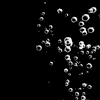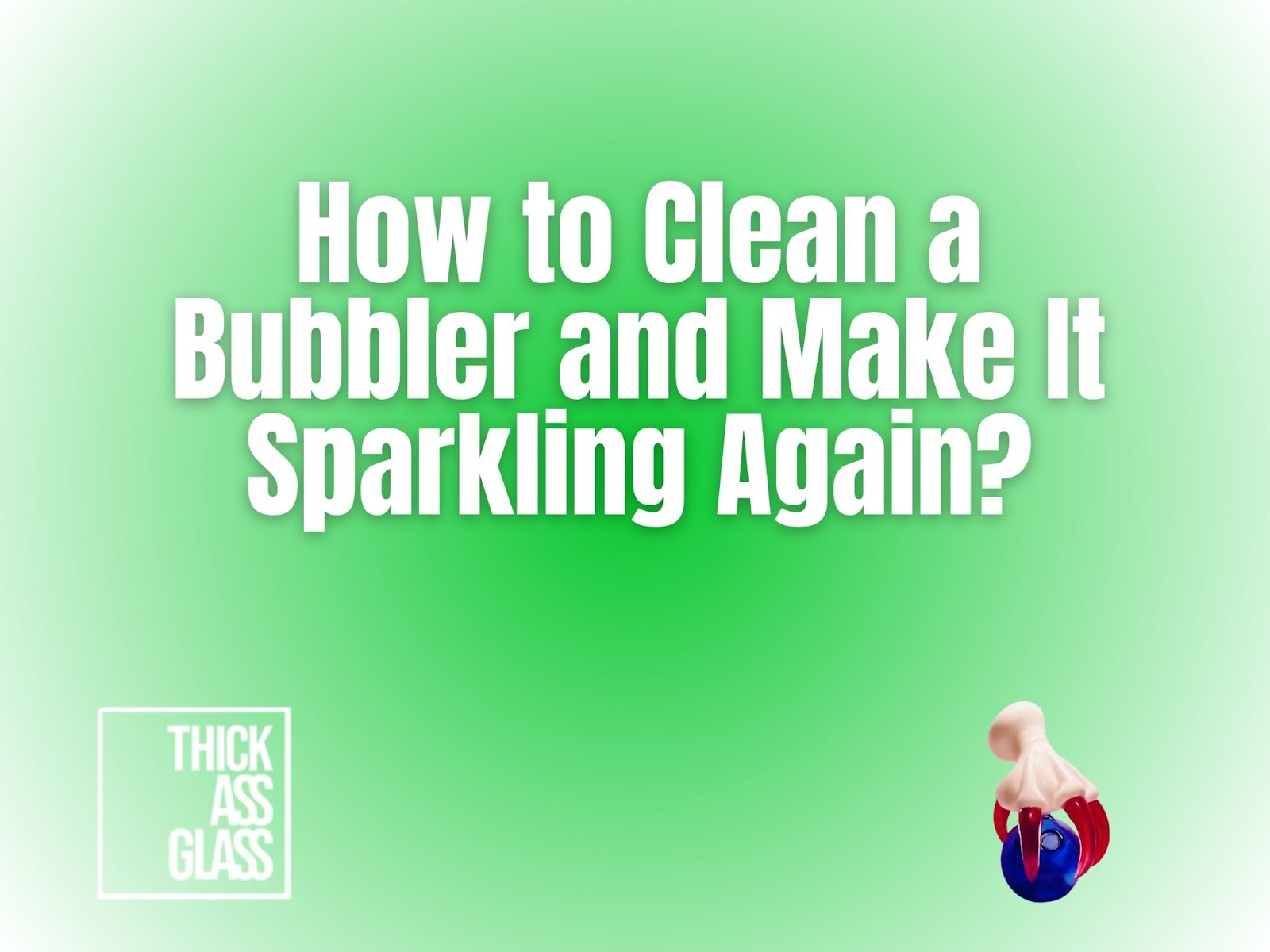Bubblers are built for smooth, filtered hits. But once resin sets in, the airflow gets tight, the flavor gets dull, and your piece starts smelling like a bad decision. Cleaning your bubbler isn’t optional unless you’re cool with stale hits and mystery gunk.
This guide gives you a clear process to get your glass clean, keep it that way, and extend its lifespan.
Here's what you'll need:
-
Isopropyl alcohol (91%–99%)
-
Coarse salt or Epsom salt
-
Ziplock bag or sealable container
-
Pipe cleaners or long cotton swabs
-
Gloves (optional)
-
Clean towel or paper towels
Thick Ass Glass makes sure to design every bubbler with thick borosilicate walls and optimized airflow so that maintenance is easier and function stays dialed in. Our pieces aren't just durable, they're built to stay that way even after repeated cleaning.

In this article, you’ll learn exactly how to clean a bubbler from daily upkeep to full deep-cleaning. We’ll also cover what to do when resin won’t budge, how to avoid common cleaning mistakes, and why proper storage helps your gear last longer.
Why Glass Bubblers Are Easy to Own and Clean
If you're using a glass bubbler, you’ve already made a solid choice. Glass delivers a smoother hit and gives you full control over airflow, draw resistance, and flavor. But it’s not just about the hit.

Cleaning glass is easier, more effective, and more predictable than any other material. With the right piece, regular upkeep becomes second nature instead of a frustrating chore.
Why Glass Is the Preferred Material
Glass doesn’t hold onto flavor. That’s one of the biggest reasons serious smokers stick with it. Silicone might bend and bounce, but it also absorbs odor and taste. With glass, you get a clean slate every time. The surface is non-porous, which means resin sits on top instead of sinking in.
When it’s time to clean, you’re removing buildup, not scrubbing away at stains that never leave.
You can also see exactly what you’re working with. That’s something no metal or ceramic pipe can offer. One look and you know whether your bubbler needs a rinse or a full soak.
Add in features like straight necks or fixed downstems, and you’ll find yourself spending less time with pipe cleaners and more time enjoying your piece.
Why You Should Keep It Clean
When resin builds up, you’ll notice it in every pull. The airflow feels tight. The flavor starts to burn. And eventually, smoke just doesn’t move the way it should. Keeping your glass clean isn’t about perfectionism, it’s about performance.
A clean chamber lets air move freely and evenly. That means smoother hits and better diffusion.
Glass that’s neglected can also start to weaken at the joints, especially around downstems and mouthpieces. Regular cleaning prevents grime from working into the connections and creating pressure points over time. For anyone who shares a bubbler, there’s also the hygiene factor.
Clean glass cuts down on exposure to old water and bacteria, especially when sessions get passed around.
TAG Bubblers to Keep Your Setup Tight
If you want glass that’s built to stay clean and easy to maintain, here are three options from Thick Ass Glass that deliver on function and durability:
-
9" Fixed 12-Arm Tree Perc Sherlock Bubbler — Smooth diffusion through twelve arms, reinforced base, and a bent neck for comfort.
-
5.25" Dragon Claw Bubbler — Compact but punchy, with thick glass claws around the chamber and a surprisingly smooth pull.
-
12" Single Ratchet Bubbler Bong — One of the easiest full-sized bubblers to clean, with a clean inline setup and sturdy grip.
Daily & Weekly Care: Keep It Fresh at All Times
A bubbler that stays fresh is easier to maintain and performs better every time you light up. Daily habits do most of the heavy lifting when it comes to avoiding clogs and keeping your hits smooth.
These aren’t complex routines or time-consuming steps. They’re quick touchpoints that make a noticeable difference in flavor, airflow, and cleanliness. If you stay on top of these, deep cleans become less frequent and much easier when they are needed.
Change the Water Every Time
Clean water gives you a clean hit. That’s the simplest rule to follow. If the water sits too long, it starts collecting residue and odor that travels straight into your lungs.
Always empty your bubbler after a session and refill with fresh water before the next one. Look for any color changes or cloudiness. Those are clear signals that your water is doing more harm than good.
Mini bubblers in particular need this attention. Since their water chambers are smaller, stale water has more impact on flavor and airflow. Changing water regularly in a piece that size gives you a fresh start with every pull.
Clean the Bowl and Downstem
Resin and ash collect fast inside the bowl and downstem. If you wait too long to deal with it, airflow starts to tighten up. After every few sessions, rinse the bowl under warm water and use a cotton swab dipped in alcohol to clear out any buildup.
The downstem can be cleared the same way. If your piece has a fixed downstem, a soft pipe cleaner or baby bottle brush makes it easy to reach inside without scratching the glass.
Wipe the Mouthpiece
It only takes a second to wipe down the mouthpiece, but it makes a big difference. Especially if you’re sharing, this step cuts down on bacteria and keeps everything feeling smooth and clean.
Use a cloth, paper towel, or even an alcohol pad if needed. It’s a quick pass that adds polish to every session.
Deep Cleaning: The Alcohol + Salt Method (Step-by-Step)
Even with good habits, resin builds up over time. That’s where a full deep clean comes in. It restores your bubbler to its original condition and keeps every hit tasting clean.
Using isopropyl alcohol and coarse salt is still the most reliable method out there. It’s inexpensive, simple, and highly effective when done right. The key is knowing when to do it and taking your time with each step so you don’t miss the spots that matter.

When to Deep Clean
The most consistent schedule for deep cleaning is once a week for daily users. If your bubbler starts pulling unevenly or if smoke feels harsh despite clean water, it’s time. You’ll also notice visual cues like brown streaks, sticky buildup in the neck, or lingering odors that don’t go away after a rinse.
For people who use their bubbler less frequently, go by feel and sight. The glass should look clear and smell neutral. If it doesn’t, plan a deep clean before your next session.
Step-by-Step Process
1. Rinse With Warm Water
This removes loose ash and surface-level residue. It also preps the glass by loosening material and slightly warming the walls, which helps alcohol work more efficiently. Always use warm water and avoid sudden changes in temperature.
2. Add Alcohol and Salt
Pour about a quarter cup of coarse salt into the bubbler, followed by enough isopropyl alcohol (91 percent or higher) to fill the chamber halfway to two-thirds. The salt acts as an abrasive scrubber while the alcohol breaks down the resin chemically.
3. Seal and Shake
Cover every opening with either silicone plugs or your hands. Shake firmly but not violently. Over-shaking has cracked more glass than most people admit. If you have a curved neck or heavy percs, use a towel to hold the piece securely. Some users recommend shaking in short intervals to avoid accidents.
4. Let It Soak
Once the initial shake is done, let the bubbler sit. For minor buildup, thirty minutes is usually enough. For pieces that haven’t been cleaned in a while, leave it overnight. A long soak might be necessary to get rid of hard core residue.
5. Scrub the Tough Spots
Use a pipe cleaner, cotton swab, or baby bottle brush to get into tight spaces. For areas like the neck or under the bowl joint, tie floss to a pipe cleaner for extra reach. On multi-perc bubblers, you may need to repeat the scrub more than once depending on how much diffusion your piece offers.
6. Final Rinse
Flush everything out with warm water. Repeat until there’s no alcohol smell and the glass feels smooth again. If your tap water leaves spots, use filtered or distilled water for the final rinse. You can also add a splash of lemon juice to neutralize lingering scent.
7. Air Dry
Flip the bubbler upside down onto a clean towel and let it dry naturally. If you want to speed up drying, compressed air works well for clearing moisture from necks and percs. Sunlight can help dry faster and reduce mildew risk, especially if you're storing it right after.
Stubborn Grime? Here’s How to Fight Back Without Breaking Glass
Some builds of resin take more than just salt and alcohol. If your bubbler has been sitting for a while or the interior has hard-to-reach percs and chambers, you may need to step things up. The key is to stay methodical and be patient.
Aggressive scrubbing or shaking can crack thinner glass, especially around narrow joints or curves. But with the right technique and a well-built piece, even the most stubborn grime can come off clean.
Here are a few tried-and-true methods for getting rid of heavy buildup:
-
Hot Water Pre-Soak: Run hot water through the bubbler before using alcohol to loosen resin and reduce the need for vigorous shaking
-
Acetone (Only for Glass): For extreme buildup, acetone works well but must be used carefully and rinsed thoroughly with warm water afterward
-
Boiling Method: Only safe if done slowly. Place the bubbler in cool water and bring it up to a boil gradually. Never drop cold glass into hot water
-
Dental Picks or Floss: Tie floss to a pipe cleaner to reach inside tight necks or downstems without scratching
-
Vinegar Rinse After Acetone: Helps eliminate chemical smell and adds a final polish to the glass
Store It Like You Respect It
Cleaning your bubbler is only part of the job. How you store it plays just as big a role in keeping it fresh, functional, and long-lasting. Clean glass left wet or exposed to the elements will start collecting dust, moisture, and airborne grime. That buildup eventually makes its way back into your hits.
Once your bubbler is dry, give it the kind of storage setup that protects your investment and keeps it ready to go.
Smart Storage Tips
After cleaning:
-
Keep your bubbler upright in a padded case or drawer
-
Avoid storing it in direct sunlight, which can discolor or weaken some finishes over time
-
For long-term storage, place it in a sealable bag or container to block dust, moisture, and airborne residue
If your bubbler includes detachable parts like a bowl or downstem, store those separately to avoid joint pressure. Always make sure everything is bone dry before packing it away.
Take the Time to Freshen Up Your Hits
Clean gear pulls better. It’s that simple. When your bubbler is clear and dry, airflow opens up, flavor comes through, and everything works like it’s supposed to. A little time spent keeping it clean pays off every time you use it. That’s the difference between just owning glass and actually enjoying it.
If your current piece is getting harder to maintain or never felt quite right to begin with, it might be time to upgrade. We build every TAG bubbler with smooth draw and easy cleaning in mind.
If that sounds like something you’re into, take a look at what we’ve got in our product collection at Thick Ass Glass website.


